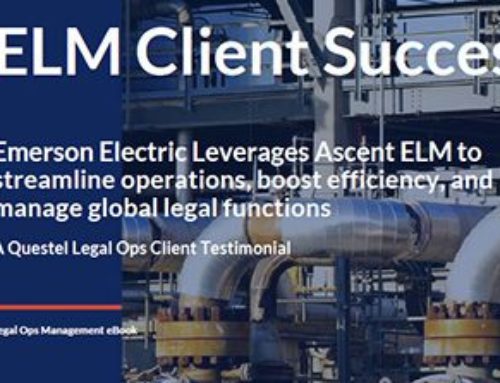Part Three of the Five-Part Series “Top 5 ELM Benefits” – Cost Savings
Build a Stronger Case for ELM with Proven Benefits Through Cost Savings Ideas

Many Legal teams struggle to find evidence that proves the value of advanced legal technology. At the same time, finding the budget to purchase anything new is critical to handling the additional tasks that today’s global business environment asks of Legal Departments. More responsibilities, more say in strategic business decisions, and the shortage of additional staff all contribute to the need for additional assistance. As stated in our last blog article, it remains increasingly important to gather evidence that erases any doubts if you want to add more tools. Enterprise Legal Management (ELM) systems are built to optimize the Legal Ops’ ability to reduce expenses and make more efficient use of data.
ELM provides the most compelling Cost Savings Ideas to validate the technology purchase
The best evidence comes from ELM solutions that create cost-saving opportunities for the entire business. That is the focus of this blog article, but that is only one answer to the question that helps decision-makers sign the purchase order for Ascent ELM. What is that big question? Simply stated it’s this, “What benefits can my organization expect after implementing an ELM solution?” Over the next installments in this blog series, we’ll continue to explore those answers together.
In this series of blogs, we will continue to take a deep dive into the Top 5 benefits of ELM.
Read the blog: ELM Benefit #1 – Increased Efficiency
Read the blog: ELM Benefit #2 – Data Transparency
ELM provides cost savings ideas that make it #3 in our Top 5 list
Corporations face increased pressure to lower operating costs, but they must also have the confidence that they can remain competitive in a rapidly growing global business environment. One common way of accomplishing this is to require all business units (departments) to reduce expenses. In fact, Legal Department clients have reported that they’re being asked to cut outside legal spending by as much as 20%. As stated earlier, Legal is shouldering more responsibilities than ever before. So how can they take on more work and still lower expenses to meet goals? Clients tell us that they have two choices when faced with these new business goals:
-
-
- Cut Legal staff and redistribute workload to remaining staff.
- Explore new ways to significantly cut costs.
-
Clients view the quick fix of reducing staff as negative because it often leads to overworked teams, lack of job satisfaction, and lower morale. Not to mention the lost expense in building their skills. This can result in the “Law of Diminishing Returns.” That’s where the benefit of reducing FTEs initially reaches the spend reduction goal, but the same workload can’t be managed for long by reduced staff. The extra work wears down the remaining team and they begin to make mistakes, miss tasks, or simply leave for a less stressful job. Then it’s inevitable – the work can’t be done! Sooner or later, the workload increases again, and the only solution is to add more staff. Reducing staff doesn’t work in the long run, so Legal needs a better solution.
Businesses must seek sustainable ways to get the work done more efficiently while meeting their cost-saving goals. Advanced LegalTech has long been a more viable way to achieve this. In the long run, it can even provide enough ROI to pay for the solution. Adding technology to the tool set comes with a number of pros and cons that may add costs to your solutions. Evaluate the total cost of ownership to determine the best path forward for your organization.

Pros:
1. Technology enables teams to handle more tasks in less time
2. Process automation provides significant cost savings
3. Vendor consolidation offers ways to combine costs
4. Systems collect and provide rich data points to help identify savings opportunities
5. Business data is more transparent, allowing business units to easily collaborate to save expenses
Cons:
1. The initial cost to bring in the tool (implementation, consultant fees, training)
2. Employee lack of adoption
3. System complexity issues
4. Cost of customization to fit existing processes
Costs vary by provider. Do your homework and you’ll find that some ELM software providers have a low upfront cost, but charge for everything after the sale. These hidden fees can create “buyer’s remorse” because the unexpected monthly invoices are different each time. Ascent ELM is one of the few solutions that give you an all-inclusive upfront cost at a predictable price each month. The result? Less stress and uncertainty: Our clients say it gives them peace of mind.
Ninja Tip: No one wants to live in doubt about the cost of their ELM solution. Not every provider charges the same for its services: some charge for any change or additional capabilities you might add after you sign. They may also charge for any customization you request in the future. Seek out the providers that deliver an all-inclusive product like doeLEGAL’s Ascent ELM that includes system configuration at no extra charge and without consultants. The cost is upfront and predictable.
What are the top ELM cost savings ideas?
Ascent ELM has proven its ability to reduce legal department expenses and fees in many areas, regardless of its global location or the markets they serve. Many savings opportunities span the entire business, some span across business unit lines to compound the savings, and still others focus on the Legal department itself.
 The most common saving opportunities are:
The most common saving opportunities are:
1) Automating repetitive processes and repurposing staff onto higher-value tasks
2) Boosting team efficiency with workload improvements
3) Consolidating vendors
4) Eliminating the billable hour with AFAs
In the age of global business, it’s critical that businesses be as cost-conscious as possible. To understand how one system can benefit the entire business, we will demonstrate how each area of savings is possible to reach. Because there are other savings opportunities that may be available to your unique business, it’s always best to speak to an ELM expert.
We’ll use client case study data to help show the powerful information that helps you choose with greater confidence.
1. Automate Processes & Repurpose Staff
Legal departments have defined processes that allow the team to manage their coordinated workload. One notable change is that the Legal departments are now facing increased responsibilities beyond the typical legal tasks and risk avoidance work. The new work they shoulder covers areas such as business strategic input, corporate responsibility governance, brand reputation, intellectual property protection, etc. – and those additional needs bring in more work. How can a team take on more responsibility with the same if not fewer staff?
Automation has long been the buzzword to improve savings, but what does it really include? Automation within the Ascent ELM system comes down to creating more efficient ways to handle multiple, repetitive tasks without assigning them to the team. By configuring the system to process invoices with the appropriate billing rules and corporate review procedures (approvals, adjustments, or rejection criteria), many tasks can be completed by the system in a fraction of the time. This can save a corporation handling thousands of invoices millions of dollars in cost savings in one year.
Let’s explore how this is possible. One way is that ELM systems can provide a “first-pass” automated rules check on all invoices submitted to ensure they are properly coded in compliance with UTBMS standards as well as corporate billing guidelines before a human ever gets involved. Once it passes this automated review, it enters the human review queue and is routed to the correct person for approval. By allowing the system to handle this first-pass check, an invoice with a net 30-day review can be completed in 3 days. Clients report that this rapid bill payment opens up another opportunity for savings – allowing them to take advantage of early-payment discounts which can amount to 2% of the invoice. Automation can also eliminate human error during the review phase which adds up the savings by eliminating non-compliant invoice reviews’ wasted time, incorrect invoice approvals, or duplicate payments. The clients’ end results continue to report multi-million dollar savings across the board.
Additional automation benefits often show in the form of improved inter-departmental communication, in-house & outside vendor collaboration, and business data integration. With automation in place, the more routine workload can be handled by the ELM system itself, which allows staff to be repurposed on higher-value tasks like research, court filings, and case preparation. Legal has long been seen as a market with a “revolving door” syndrome where people quickly change jobs more often than in other markets. Clients report that ELM has improved job satisfaction ratings which helps keep good people in place longer. This saves money in hiring, training, and maintaining performance levels. We will cover this benefit more in-depth in our next article.
2. Improving Team Efficiency
One of the most desirable improvements sought by Legal Operations is Efficiency. Having access to advanced tools has been the battle cry for many teams that seek to have better control over the evolving and expanding workload they face today. But will more tools lead to more efficiency? The proof says yes, but to gain the most benefit, the tool has to match your needs. To understand the concept of efficiency more, let’s first ask, “How is team efficiency measured?” Team efficiency is measured in a number of ways and each corporate legal department may have unique criteria to add to the equation. The basics come down to applying the correct skill sets/staff to the task at hand, task completion rates, end results, and the cost to attain those outcomes. If the team can answer these criteria positively, then their efficiency rates increase. Many businesses don’t have a system in place to even measure these or have a home-grown method to record their process. Without insights on how to improve these, it is an uphill climb. The answer for many is to bring in tools like Ascent ELM to provide those insights and identify areas for further improvement.
Providing this deep dive into the data and delivering improvement insights is part of the holistic design of Ascent ELM. These systems collect operational data, process and analyze it, and then deliver insights on your spending, where things are working well, and where things are not. Team efficiency can now be transparent and once you know how and where you are spending your time and money, you can begin the process of improving it. No one can dispute the overwhelming evidence that when a business improves its efficiency, it will save more money
3. Consolidate Vendors
Most legal departments have a list of outside counsel and legal vendors they have as go-to resources. Other corporations allow them to pick and choose who they work with on a case-by-case basis. From our experience working with hundreds of clients, there are best practices that help provide optimal savings opportunities. With this in mind, we share those practices with you.
One of the first savings opportunities comes from Vendor Consolidation. Imagine having hundreds of outside counsel with no rules or direction on whom to use for which tasks. It’s impossible to gain any cost savings using this practice. However, when you diligently vet your list of outside counsel and consolidate them down to the best of the widely varied groups, you find a much smaller collection of firms that can handle your needs well. You intelligently evaluate the law firms, score them by their ability to handle tasks, and this analysis provides your “Top Gun” list of the best of the best vendors. What if your ELM system could generate this list for you with a simple report already built into it? It would save you time, money, and loads of staff effort. Ascent ELM systems deliver this information to you in the form of Vendor Scorecards where each vendor is graded on their performance over time as well as their costs to do each task. Ascent ELM makes it easy!
Once your entire legal department uses this list for outside legal work, you unlock the power to negotiate better pricing with your outside counsel and third-party vendor list. The relationship becomes a two-way business relationship through building a stronger, trusted partnership based on performance and price. The law firm gains a more predictable revenue stream handling the assigned tasks you agree on. For this promise, your work is handled by a trusted partner that agrees to do that work at a preferred cost.
4. Eliminate the Billable Hour with AFAs
It has been a long, slow process to replace the billable hour in favor of Alternative Fee Arrangements (AFAs) which are flat-rate, capped, or contingency-based billing. Why? The days of writing a law firm a blank check are numbered because there’s little oversight, justification, or rate negotiation. The mindset of “That’s what we always charge” is quickly disappearing. Clients demand more service and support from their law firms, at a lower rate. What’s the solution? As the billable hour sunsets, legal departments are embracing the benefits of performance-based billing methods. As the trend continues, ELM systems are quickly adding this capability to provide more predictable billing methods. doeLEGAL provides a complete Ascent ELM module devoted to applying and managing this billing method to provide extreme oversight and reporting on all matters.
ELM systems can handle most billing methods, but the benefit of Ascent ELM comes from its ability to help teams decide on the best method for their legal needs. To simplify the path the greater savings, Ascent ELM provides a complete AFA component built into the system to help clients leverage this advantageous change. AFA capabilities offer the ability to track actual costs vs. AFA billing, so teams can compare the billable hour vs. the performance billing. Billing methods often change: To ensure the most savings, it’s best to choose an ELM system capable of tracking, analyzing, and reporting on every matter cost. Know where and what you’re spending.

What are Ascent ELM Clients Saying?
Client Success is always the focus when it comes to measuring business success for doeLEGAL. When clients gain the most from their ELM system, we’ve kept our promise to deliver optimized legal technology. Clients want time- and cost-saving ideas to prove their decision was a good one, and they provide the business with the best chance for success. ELM systems are proving their worth time and time again, but it’s the recurring results that prove it.
Let’s take a few reported examples from global market-leading businesses to demonstrate the extreme savings possible with Ascent ELM. Their experiences within various disparate markets over the past years clearly offer the evidence you can use to build a winning case for ELM technology.

Ninja Tip: Using evidence that cost savings ideas used by other businesses work makes it reasonable to conclude that other businesses with similar business markets can gain similar benefits with the right provider supporting their efforts. The system is only one component to reach these levels of cost savings. Having knowledgeable ELM experts in your corner, ready to apply their expertise to your system, is another important factor to consider. doeLEGAL has numerous success stories and clients willing to share their experiences with you. Their cost-saving results demonstrate how Ascent ELM exceeded expectations. Download client stories here.
What’s next?

In this series of blogs, we will continue to cover the top five benefits of ELM and what each offers to modern business teams.
Next, we’ll cover the fourth benefit of implementing ELM systems in year #1 – Repurposing resources, both internal and external.
If you’re ready to move forward; you can also request a demo now.





